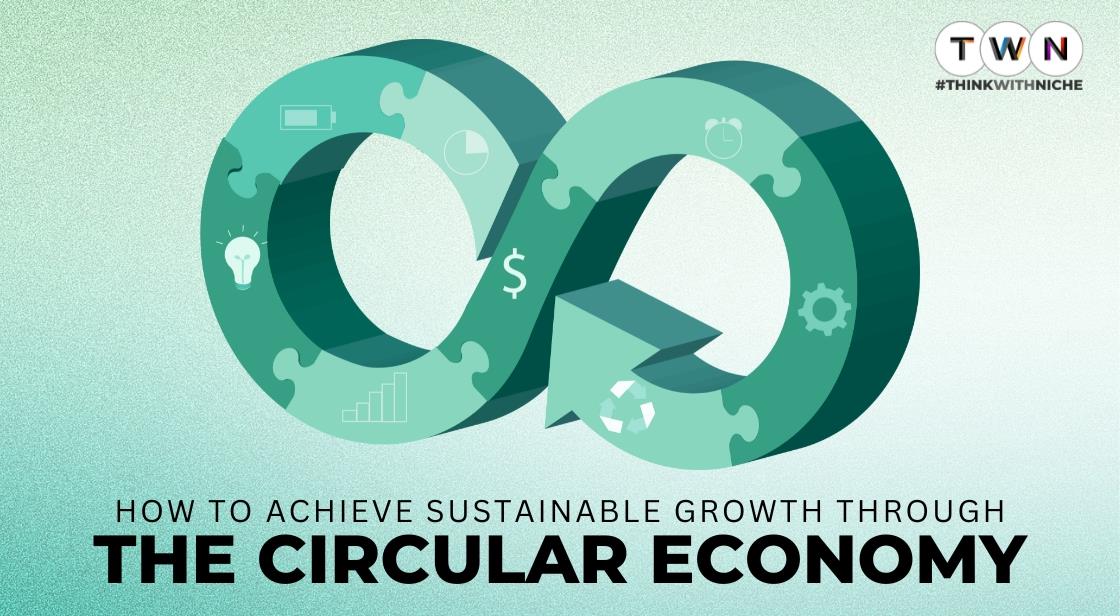How to Achieve Sustainable Growth through the Circular Economy

Blog Post
Welcome to the world of the circular economy, where waste becomes a thing of the past and sustainable growth becomes the new norm.
In this article, we will explore how the circular economy presents an opportunity to enhance resource efficiency, mitigate environmental impacts, and pave the way for a more sustainable future.
From understanding the principles of the circular economy to examining its economic and environmental benefits, we will delve into the various aspects of this transformative concept.
We will also explore the role of consumers, the challenges faced, and the innovative technologies driving the transition to a circular economy. So, get ready to embark on a journey towards sustainable growth as we uncover the potential of the circular economy.
Imagine a world where waste doesn't exist. Where our economic system operates like nature itself - in a circular mode, gracefully and efficiently. Sounds exciting, doesn't it?
Well, it's not just a utopian dream. It's a budding reality called the circular economy. This promises a pathway to sustainable growth but also presents an opportunity to enhance resource efficiency and mitigate environmental impacts. Intrigued?
Let's delve into the world of the circular economy and discover the sustainable growth it promises.Imagine an economy where waste is virtually non-existent, resources are continually reutilized, and the natural environment is preserved.
But here's the big surprise - it's possible, and it's happening through the circular economy.
The circular economy isn't just about recycling. It's a comprehensive approach that involves redesigning our systems, products, and services to minimize waste, keep resources in use for as long as possible, and regenerate natural systems.
How to Achieve Sustainable Growth through the Circular Economy
What is Circular Economy?
At its core, the circular economy is a regenerative system. In stark contrast to the traditional linear 'take-make-waste' model, it rests on three principles: reduce, reuse, and recycle. Its goal?
It's not just a fancy term for better waste management - it's a fundamental rethinking of how we interact with resources.
It's about creating systems that are not only sustainable but that can actually enhance and restore our environment.
In other words, it's a model for economic growth that benefits us all, without harming our planet.We need to start embracing the circular economy, a game-changing concept that could reshape our world for the better.
A circular economy is about much more than just recycling or reusing materials. It's about redesigning our systems and processes to eliminate waste, keep products and materials in use, and regenerate natural systems.
From Linear to Circular: How a Circular Economy Works
Imagine your favorite pair of jeans. The journey they've made to get to your wardrobe is likely a linear one. They were designed, manufactured, bought, worn and eventually, they'll reach their end of life and be discarded, right?
This is the 'take-make-waste' model, often dubbed as a linear economy. But there's an alternative path your beloved denim could take - one that is circular.
Here's where the concept of a circular economy emerges. In this innovative model, resources are kept in use for as long as possible, extracting the maximum value from them while in use.
After that, the products and materials are recovered, regenerated and recycled back into the system, creating a closed-loop system. It's like giving your jeans a new life!
Shifting from a linear to a circular model is not just about recycling or being eco-friendly. It's a fundamental restructuring of how we view and use resources. This change of perspective can drive sustainable growth, enhance resource efficiency, and mitigate environmental impacts.
"Only 9% of the world's economy is circular, leaving significant room for improvement."
Embracing the Circular Economy: Why it Matters
Adopting a circular economy is not only good for the planet; it's also good for business. A McKinsey study found that shifting toward circularity could add $4.5 trillion to the global economy by 2030.
The reasons? Cost savings from improved resource productivity and new revenue from innovative business models.
Moreover, the circular economy can help companies reduce their environmental footprint, meet regulatory requirements, and build positive brand reputation. In a world increasingly concerned with sustainability, these are significant competitive advantages.
The Path to a Circular Economy: Overcoming Challenges
Transitioning to a circular economy isn't without its challenges. It requires changes in product design, business models, and consumer behavior. It also requires supportive policy and regulatory environments.
But, these challenges can be overcome with innovation, collaboration, and commitment.
Companies like IKEA and Philips are leading the way, transitioning from selling products to leasing them. Governments are also stepping in, with the European Union introducing measures to promote circularity. Even consumers are playing their part, choosing products that are sustainably sourced and designed to last.
As we move forward, the circular economy is not just an option, but a necessity. It's time for all of us - businesses, governments, and individuals - to embrace circularity and drive the path towards sustainable growth.
With a focus on reducing waste, maximizing resource efficiency, and mitigating environmental impacts, the transition to a circular economy has the potential to revolutionize the way we live and work.
It's a paradigm shift that calls for innovative thinking, collaborative efforts, and determined action. The journey might be challenging, but the reward - a sustainable and prosperous future - is undeniably worth it.
Creating a Closed-Loop System to Reduce Waste
Picture this: A world where waste is not an end product, but a raw material for something new. This isn't a sci-fi movie plot, but a concept called closed-loop system, a cornerstone of the circular economy.
In a closed-loop system, waste doesn't end up in the landfill. Instead, it's turned back into the production cycle, creating a loop that recycles resources rather than discarding them. It's the ultimate recycling model where nothing goes to waste.
Why Should We Embrace the Closed-Loop System?
Here's the deal: the world's resources aren't infinite. The closed-loop system is a step towards preserving these resources by minimizing waste and maximizing their use. It's like throwing a boomerang that brings back what we toss out, only in a more valuable form.
Moreover, the closed-loop system helps mitigate the environmental impacts of waste. Think about the amount of waste that ends up in our oceans or landfills. By recycling these materials, we're not only reducing pollution, but also limiting the extraction of new resources.
The Economic Perks of the Closed-Loop System
You might be wondering, "What's in it for me?" Well, aside from contributing to a healthier planet, the closed-loop system can actually drive economic growth. Companies can cut costs by using recycled materials, and new jobs can emerge from the need for waste processing and recycling.
Moreover, consumers are becoming increasingly conscious about their environmental footprint. Brands that embrace sustainable practices like the closed-loop system are likely to attract these eco-conscious consumers, breeding customer loyalty and potentially boosting sales.
Creating a More Sustainable Future
Transitioning to a circular economy and implementing the closed-loop system won't happen overnight. It requires collective effort from businesses, governments, and individuals. But every step we take is a stride towards sustainable growth, resource efficiency, and a healthier planet.
In the end, the closed-loop system is more than just a recycling model. It's a manifesto for a more sustainable and responsible economy. And that's a future worth striving for, don't you agree?
Also Read: Sustainability Strategies for Businesses: Tips for Going Green
"The circular economy could generate $4.5 trillion in economic benefits by 2030."
The Business Case for Embracing the Circular Economy
Let's talk business, folks. Have you ever considered the circular economy as your company's new game plan?
If not, buckle up because it's time to take you on a wild ride into a world where waste is a myth, growth is sustainable, and resource efficiency is king.
The Profitability of Circularity
Here is some food for thought: What if we told you that embracing the circular economy could actually boost your bottom line? Sounds a bit wild, doesn't it? But it's true. A circular economy model redefines traditional notions of growth and profitability by valuing resource efficiency and waste elimination.
Don't just take our word for it, though. The Ellen MacArthur Foundation reports that a transition towards circularity could unlock a whopping $4.5 trillion of economic growth by 2030. That's a pretty penny, right?
Resource Efficiency: More Bang for Your Buck
A key pillar of the circular economy is resource efficiency. Why buy ten when you can do the same job with five, right? Resource efficiency means producing more with less, and in a world where resources are finite, this strategy is golden.
Resource efficiency not only reduces costs but also helps mitigate supply chain risks. In a circular economy, businesses can enjoy increased operational efficiency and resilience — a win-win situation on all fronts!
Protecting the Environment: Good for Business, Great for the Planet
But it's not all about dollars and cents. The circular economy also has a green heart, aiming to reduce waste and mitigate environmental impacts. And, let's be clear, environmentally conscious business practices are no longer a nice-to-have — they're a must-have.
Companies that adopt circularity are likely to experience enhanced brand reputation, customer loyalty, and investor interest. After all, who doesn't want to support a business that's doing its bit for the planet? Long story short: the circular economy equals sustainable growth. So, are you in?
Innovative Technologies Paving the Way to a Circular Economy
We're living in an age of technological revolution, where innovation has become the lifeblood of sustainable growth. As we strive towards the creation of a circular economy, a host of cutting-edge technologies has been emerging, playing a crucial role in this transition.
Welcome to the era of resource efficiency and environmental preservation, shaped by the transformative power of technology!
Unlocking Potential with Artificial Intelligence
At the heart of the circular economy model, Artificial Intelligence (AI) presents a promising key. From optimizing resource allocation to enhancing waste management, AI's potential to revolutionize our sustainable growth efforts is unprecedented. It's like giving our planet its very own brain to intelligently manage its resources!
IoT: The Eyes and Ears of a Circular Economy
Step aside, traditional economic models! The Internet of Things (IoT) is here, providing real-time monitoring and data collection capabilities that are integral to the successful implementation of a circular economy. By enabling us to track and analyze our consumption and waste patterns, IoT is helping us to understand and minimize our environmental footprint.
3D Printing: Reducing, Reusing, and Recycling
3D printing might seem like a futuristic concept, but its potential for driving sustainable growth is very much a reality. By using recycled materials as 'ink,' this innovative technology can significantly reduce waste and encourage reuse.
The result? A step closer to a more balanced and sustainable economic model.
Technology is not just reinventing the world as we know it; it's redefining the way we think about growth and sustainability. And as we continue to embrace these technological advancements, we're building a future where the economy and environment exist in harmony. So here's to a circular economy—our pathway to sustainable growth.
At its core, the circular economy is all about 'closing the loop.' It's an economic model that encourages us to keep resources in use for as long as possible, extract the maximum value from them while they're in use, and then recover and regenerate those resources at the end of each product's life cycle.
This shift away from the traditional 'take-make-dispose' model of growth has the potential to not only boost our economy but also significantly reduce our environmental footprint.
"The circular economy has the potential to create 1.8 million new jobs by 2030."
The Role of Consumers in the Circular Economy
Waste is a myth, a mere fairy tale from the past. That's the promise of the circular economy - a revolutionary approach that's all about reducing, reusing, and recycling. But for this to become a reality, we consumers need to play our part.
Reducing Consumption: Less is More
In the circular economy, less is indeed more. The first step is to minimize our consumption, focusing on quality over quantity. This means buying fewer, but better items that last longer, reducing the need for constant production and the resulting waste.
Reusing and Recycling: The Second Life of Products
We've all heard the mantra "Reduce, Reuse, Recycle," but in a circular economy, these words take on a whole new meaning. Rather than disposing of items after a single use, we can give them a second, third, or even fourth life. Whether it's by upcycling an old piece of furniture, donating unwanted clothes, or composting organic waste, every little bit helps.
Conscious Buying: Supporting Sustainable Brands
Finally, we as consumers have the power to drive change through our purchasing decisions. By choosing to buy from brands that prioritize sustainability and ethical practices, we can help promote a more circular economy.
After all, every dollar we spend is a vote for the kind of world we want to live in.
Embracing the circular economy isn't just a pathway to sustainable growth - it's a journey towards a better, more responsible future. And as consumers, that journey starts with us.
Challenges to Implementing a Circular Economy
Oh, the allure of a circular economy! It's a concept that's as enticing as a well-baked apple pie. But, like any good recipe, it comes with its fair share of challenges. Let's break it down and see what we're up against on this path to sustainable growth.
1. The Knowledge Gap
First off, there's a lack of awareness and understanding about the circular economy. It's like trying to cook without a recipe. How can you create a delicious dish if you don't know what ingredients you need or how to put them together? We need to spread the word and educate people about the benefits and practicalities of a circular economy.
2. Legal Roadblocks
Next, we have legal and regulatory barriers. Think of these as restrictive dietary requirements that prevent us from using certain ingredients in our recipe. Existing laws and regulations are mainly geared towards a linear economy, and transitioning to a circular model will require some innovative legal baking.
3. Economic Hurdles
Lastly, there are economic challenges. These are like expensive ingredients. The initial cost of transitioning to a circular economy can be steep, particularly for small businesses. But, like any good investment, the long-term benefits will outweigh these upfront costs.
So, there you have it. Implementing a circular economy is not a piece of cake, but with the right ingredients, we can whip up a sustainable future that's as delicious as it is eco-friendly. Now, who's ready to don their apron and embrace the circular economy?
Let's roll up our sleeves, get our hands dirty, and start baking a better tomorrow, one sustainable slice at a time.
Real-World Examples of Circular Economy in Action
Let's take a rollercoaster ride around the globe, highlighting some of the most impressive cases where the concept of the circular economy is having a real-world impact.
You'll be surprised to see how businesses, communities, and even entire countries are embracing this transformative approach. Let's buckle up and discover the magic of sustainability in action.
1. The Netherlands: A National Strategy
You might want to get your wooden clogs ready because our first stop is the Netherlands. A country that isn't just famous for its tulips and windmills but is also leading the way in circular economy implementation.
The Dutch government has set an ambitious goal: to achieve a 100% waste-free economy by 2050. Quite a challenge, right?
2. Interface: Repurposing Fishing Nets
Next, let's visit Interface, a company that's making waves in the manufacturing industry. They've ingeniously decided to turn discarded fishing nets into high-quality carpet tiles. This not only eliminates waste but also gives a new lease of life to an otherwise discarded resource. It's the perfect example of one man's trash being another man's treasure!
3. Ellen MacArthur Foundation: Rethinking Plastic
Finally, we land at the doorstep of the Ellen MacArthur Foundation. The foundation has partnered with several global businesses to rethink the way we use plastic, developing a new initiative called the 'New Plastics Economy.'
The goal? To transform the plastic packaging sector into a circular, sustainable system where no plastic becomes waste. A future where our oceans are no longer swimming with plastic? Sign me up!
These are just a few of the many exciting examples of the circular economy in action. Each story showcases the transformative power of sustainability and resource efficiency, proving that a greener future isn't just a dream—it's already happening.
And remember, this is just the beginning. The world is our sustainable oyster, and we're here to crack it open.
"The circular economy could reduce global greenhouse gas emissions by 39% by 2050."
Collaboration and Partnerships: Key to a Successful Circular Economy
Let's dive right into the heart of the matter. It's no secret that the transition to a circular economy requires more than just individual or corporate efforts. In this grand scheme of things, collaboration and partnerships play a pivotal role.
Why, you ask? Well, a circular economy does not only involve reducing waste or recycling. It's about creating a system where resources are continually used and reused, and for this to happen, every link in the value chain must actively participate.
From Competition to Cooperation
Typically, businesses are used to operating in a competitive environment. But in a circular economy, companies need to shift from competition to cooperation. Sharing resources, technology, and knowledge can lead to innovations that not only benefit individual businesses but also the entire ecosystem.
Multi-stakeholder Partnerships
But it's not just about businesses. Achieving a circular economy needs the involvement of all stakeholders - governments, NGOs, academia, and even consumers. Partnerships among these different entities can lead to breakthroughs that accelerate the transition to a circular economy.
The Power of Collective Action
What we're talking about here is the power of collective action. When everyone works together toward a shared goal, it becomes easier to overcome challenges and make significant progress. So, the key to a successful circular economy? It's collaboration and partnerships.
It's time we all roll up our sleeves and get in this together. Because the path to sustainable growth is a road best traveled with others. Let's embrace the circular economy and build a better future for us all.
Measuring the Success of a Circular Economy
Let's talk success metrics. The circular economy isn't just an enviro-buzzword—it's a business model that’s redefining how we perceive growth and progress. But how do we measure its success?
-
Efficiency, Not Excess
In traditional linear models, success is often equated with excess. The more you make and sell, the better. The circular economy, however, flips this concept on its head. Here, it's not about making more—it's about making better.
The circular economy values resource efficiency over excess production. This means using less to make more and ensuring that nothing goes to waste. The efficiency of resource utilization, therefore, becomes a key indicator of success.
-
Sustainability Over Short-Term Gains
A circular economy's success is also measured by sustainability. It's all about the long game instead of short-term gains. Businesses that thrive in the circular economy aren't just profitable—they're sustainable.
This sustainability is measured in terms of environmental impact and the longevity of the resources used. A successful circular business minimizes its ecological footprint and maximizes the life cycle of its resources.
-
Value Creation and Social Impact
Lastly, a successful circular economy creates value—not just in economic terms, but in social and environmental aspects as well. This holistic approach to value creation is a vital measure of success in the circular economy.
Companies that make a positive social impact, whether by creating jobs, improving living conditions, or promoting equitable practices, are seen as successful players in the circular economy. After all, it's all about creating a system that benefits everyone—not just the bottom line.
So, if you're still stuck in the linear mindset of measuring success, it's time to think in circles. Embrace the circular economy and redefine your idea of success.
Circular Economy and the Future of Sustainable Growth
Imagine a world where waste isn't waste – it’s a resource. That is the essence of the circular economy, a model that is changing the conversation about sustainability and growth. It's a concept that could radically reshape our future, giving us the tools we need to create a sustainable, prosperous world.
-
A New Vision of Growth
At its heart, the circular economy is all about rethinking how we view growth. It's no longer about using more and more resources. Instead, it's about using resources more efficiently, effectively, and sustainably.
When we talk about a circular economy, we're talking about a system that doesn't just take, make, and dispose. It's a system that designs out waste, keeping materials in use, and regenerating natural systems. It's a model that turns the traditional 'take-make-waste' linear model on its head.
-
Driving Sustainable Growth
In a circular economy, growth doesn't come at the expense of our planet. It's a growth that is decoupled from the consumption of finite resources. It’s a growth that benefits everyone - from businesses to individuals, from cities to countries.
Businesses can become more competitive by reducing their resource costs, minimizing waste, and innovating for the future. Individuals can enjoy better, longer-lasting products. Cities and countries can reduce their environmental footprint, enhance their resilience, and create new jobs.
-
Mitigating Environmental Impacts
No discussion of the circular economy would be complete without considering its potential to mitigate environmental impacts. By keeping materials in use, we reduce the demand for extraction of new materials, thus reducing environmental degradation.
Moreover, by designing out waste, we can significantly reduce the amount of waste that ends up in our landfills and oceans. In a world that is facing an unprecedented environmental crisis, the potential of the circular economy to drive sustainable growth while mitigating environmental impacts is truly revolutionary.
So, let's embrace the circular economy. It's time to rethink growth. Because the future of sustainable growth is circular.
"The circular economy could reduce global water use by 50% by 2030."
Expert Quotes on Circular Economy
The circular economy represents a profound change in the way we produce and consume. It is a systemic shift that builds long-term resilience, generates business and economic opportunities, and provides environmental and societal benefits.
- Ellen MacArthur
The circular economy is an opportunity to transform our economy and society, and to create a more sustainable future for all.
- Frans Timmermans
The circular economy is not just about recycling; it is about designing products and systems that minimize waste, maximize resources, and regenerate natural systems.
- Kate Raworth
The circular economy is a win-win for business and the environment. It creates new markets, reduces costs, and enhances resource efficiency, while also reducing environmental impacts.
- Andrew Morlet
Conclusion:
The circular economy holds immense promise for achieving sustainable growth and resource efficiency. By embracing the principles of reduce, reuse, and recycle, we can shift away from the linear model and create a closed-loop system that minimizes waste and maximizes the value of resources.
From businesses adopting circular practices to individuals making conscious choices, every contribution towards the circular economy can drive positive change.
Although challenges exist, such as knowledge gaps and legal barriers, with collective effort and innovative thinking, we can overcome these obstacles and pave the way for a more sustainable and prosperous future.
Let us unite in embracing the circular economy, where economic growth and environmental stewardship go hand in hand, shaping a better world for generations to come.
You May Like
EDITOR’S CHOICE












